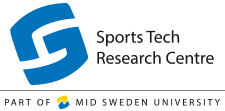Research
Sports Technology Centre is a unique Swedish environment for the engineering branch of Sports Technology.
Activities are run within one of the university’s focus areas “Forests and mountains as resources for business and quality of life” and have a strong emphasis on research in sport and the outdoors.
The research areas can be divided into three groups under the main theme “Product Development and Verification in Sports and Outdoor”:
- Biomechanics and Performance Optimization
- Human and Equipment Interaction
- Additive Manufacturing and Materials
The research topics cover an extremely wide field, from basic research on snow friction to active protective safety devices lowering injuries in sports. Multidisciplinary research teams are formed to address research questions in the best way. Research qualification ranges from mechanical engineering, materials engineering, electrical engineering, design, product development, manufacturing engineering, software and computer engineering, sports technology to the physiology, medicine and surgery. Many of the researchers are active athletes themselves.
Biomechanics and Performance Optimization
Research in the field of Biomechanics and Performance Optimization involves biomechanical analyses of the human body movements and the optimization of a range of sporting activities. Examples of problems that are studied are pacing strategies of cycle or ski races in order to give the athlete the fastest possible finish time, while taking into account the course profile, wind resistance and the athlete’s capacity, as well as other factors. These calculations use mathematical optimization linked to different models for the body’s ability to deliver power, depending on how close to maximum effort the athlete is, the length of recovery periods earlier in the race, etc.
Examples of other problems that are studied include the relationship between glide and grip on a ski, depending on the skier’s arm and leg strength. These studies include comparisons between theoretically calculated and optimized strategies with practical tests. In the tests, skiers ski on a roller ski treadmill in the planned Wind Tunnel Laboratory, on a simulated course profile using varied combinations of glide and grip to find the one that is most beneficial. This is achieved using the roller skis with variable grip that have been specially designed for use in testing on roller ski treadmills, to simulate the conditions found on snow as closely as possible.
Human and Equipment Interaction
Each sport has a defined requirements profile that describes its characteristics of its specific needs (e.g. the physiology of rally drivers and cross-country skiers and the associated equipment and products that are used in training and racing). However, sports develop continually, as regards individuals’ physiology and the sports’ equipment; this means that new experiments and the updating of existing requirements profiles is an ongoing process.
A great deal of the work conducted at Sportstech focuses on the development and resting of the products intended for use in sports. In order to study the effects of products in their intended areas of use, it is necessary to investigate the products together with the users’ physiology and biomechanics. For example, an increase in energy expenditure, in comparison to similar products on the market, is not satisfactory in sports that require endurance.
A three year project (May 2010 –August 2013) called “NUCM Vinteridrott” has improved the possibilities for athletes with a disability to perform their sports. This project was lead by Jämtland-Härjedalen’s Sports Organization for the Disabled and Mid Sweden University. The project was also partially funded by EU regional funds, local authorities, the healthcare system and the Swedish Sports Organization for the Disabled and The Swedish Paralympics Committee.
Additive Manufacturing and Materials
The research within the area of additive manufacturing (AM), or 3D printing, was initiated as a spin-off when the group invested in their first machine for prototyping. Today, the main areas of research for this group are Sports Technology, Medical Applications and Material Development. In the area of Sports technology, the group can offer state-of-the-art equipment for visual and functional prototyping, as well as on-off or small series production in both plastic and metal. Development of materials for additive manufacturing is also an important part of the research and the group is internationally accepted as one of the leading universities within this area.
Together with researchers from Uppsala University/Uppsala hospital, Lund University/Skåne hospital, Gothenburg University/Sahlgrenska hospital, a method for virtual planning of craniomaxillofacial reconstruction and direct manufacturing if implants has been developed. Studies have shown that costs can decrease and patient safety increase by using customized implants.
In cooperation with researchers from Germany and Switzerland, titanium mesh structures have been investigated where focus have been on the characterization of electro-chemical etching and its influence on cell ingrowth. The goal for this research is to find the best possible surface structure for osseointegration which in it turns will lead to that implants in the future less likely loosen and hence save costs related to operations and reduce postoperative morbidity.
A new method to include patient-specific anatomy and realistic load cases for clavicle reconstruction plates have also been developed in cooperation with Östersund Hospital, Umeå University/Umeå Hospital and Aalborg University in Denmark. So far, several plates have been designed, manufactured and tested regarding the fit during surgery and the next step in the project is to actually use the patient-specific plates manufactured in titanium in a smaller test group.

